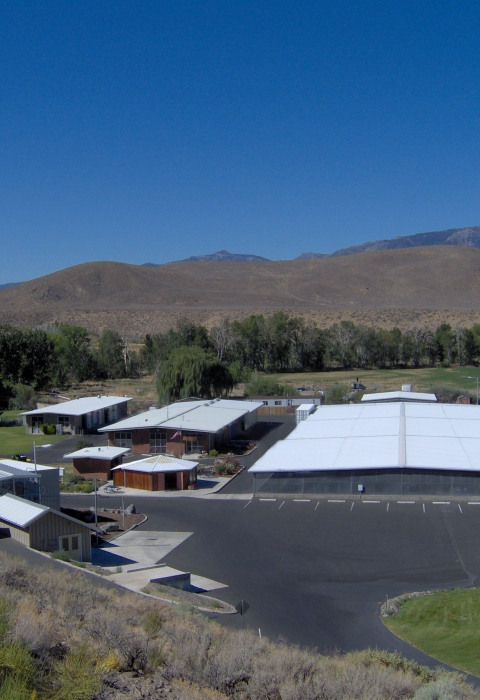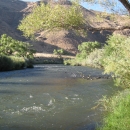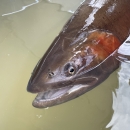About Us
Since 1871 the National Fish Hatchery system has been at work improving recreational fishing and restoring aquatic species that are in decline, at risk, and are important to the health of our aquatic systems. Across the country the network of National Fish Hatcheries work with states and tribes to conserve, restore and enhance the fish and aquatic resources of America for future generations.
Lahontan National Fish Hatchery is one of three facilities within the Lahontan National Fish Hatchery Complex. The hatchery was constructed in 1967 to provide sportfish for area waters impacted by the Washoe Project Act. Since 1992, Lahontan National Fish Hatchery has evolved to play a pivotal role in the U.S. Fish and Wildlife Service's efforts to protect and restore threatened Lahontan cutthroat trout populations in the Lake Tahoe, Truckee, Pyramid and Walker Lake Basins of Nevada and the Eastern Sierra's. The hatchery maintains a broodstock broodstock
The reproductively mature adults in a population that breed (or spawn) and produce more individuals (offspring or progeny).
Learn more about broodstock of a unique strain of Lahontan cutthroat trout, the Pilot Peak strain that represents the original lake form that evolved in ancient Lake Lahontan and is the largest inland cutthroat trout in the world. Lahontan National Fish Hatchery also works to fulfill federal tribal trust responsibilities by providing fish to our Tribal partners for recreational fishing and recovery efforts.
Our Mission
Since 1871, National Fish Hatcheries have been applying science-based approaches to conservation challenges. We work with our partners and engage the public to conserve, restore, and enhance fish and other aquatic resources for the continuing benefit of the American people. Conservation is at the heart of what we do, and we recognize that we do this work for the American people-both the present generation who benefit today and future generations who will inherit our legacy of conserving America's aquatic resources.
The mission of the Lahontan National Fish Hatchery is to conserve the genetic legacy of a fast-growing lake form of Lahontan cutthroat trout in support of recovery, tribal trust, and recreational fishing.
Our History
Lahontan National Fish Hatchery was constructed on 8-acres of land, 5 miles south of the town of Gardnerville, Nevada. The hatchery was authorized by the Washoe Project Act in 1956 and fish production operations began in 1967. Initially, the hatchery raised Lahontan cutthroat trout and other sportfish to mitigate impacts from the Washoe Project Act. After Lahontan cutthroat trout were downlisted from endangered to threatened in 1975 with a 4(d) rule that allowed for recreational fishing, more emphasis was placed on rearing Lahontan cutthroat trout at the hatchery and subsequently other species production at the facility was halted in 1978.
In 1990, Public Law 101-618, the Truckee-Carson Water Settlement Act, was signed into law. This law called for the Secretary to expeditiously revise, update, and implement plans for the conservation and recovery of the Cui-ui sucker and Lahontan cutthroat trout. The Lahontan National Fish Hatchery Complex was given the lead for recovery implementation for both the Cui-ui and Lahontan cutthroat trout in the Truckee/Pyramid Lake system, with emphasis on section 207 (a) and (b) of the act. The first recovery plan for Lahontan cutthroat trout was finalized in 1995, and called for the investigation of the ecologic and genetic importance of the lake form.
To pursue recovery of the extirpated populations of the lake form in Pyramid and Walker Lakes, Lahontan National Fish Hatchery began development of a broodstock broodstock
The reproductively mature adults in a population that breed (or spawn) and produce more individuals (offspring or progeny).
Learn more about broodstock from the out of basin population in Utah in 1995. In the early days eggs were flown to the hatchery, where a garage was retrofitted, to initiate broodstock development. After a few years a small bank of raceways was converted to a larger brood area that could be ran on single pass water and biologists developed methods and techniques for rearing this wild strain of Lahontan cutthroat trout. By 2004, Lahontan National Fish Hatchery was raising only Pilot Peak strain Lahontan cutthroat trout.
Currently, Lahontan National Fish Hatchery houses approximately 3,000 Pilot Peak broodstock for conservation, recovery, and recreational fishing. Production fish are provided only to high priority conservation waters in the Pyramid, Tahoe, and Walker Lake basins.


